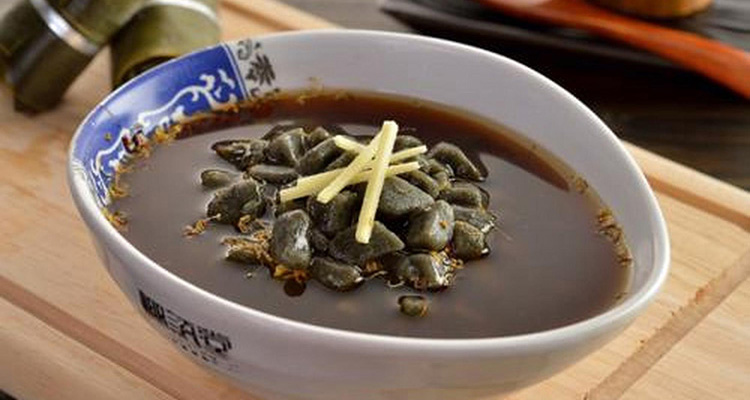Hainan glutinous rice dessert: Jishiteng Guozi
Explore Hainan’s unique Jishiteng guozi — a green, herbal glutinous-rice snack beloved in Qionghai and Wenchang. Don’t be put off by the literal name: this local specialty combines island tradition, herbal benefits, and comforting syrup for an unforgettable bite.
1.Origin and Cultural Significance
Jishiteng guozi comes from eastern Hainan, especially the towns of Qionghai and Wenchang. Its precise origins are hard to date, but the dish reflects islanders’ long tradition of combining local herbs and food for daily health. Jishiteng (Paederia scandens) is a common vine in southern China whose crushed leaves emit a scent some liken to chicken manure — hence the name — but when prepared they yield a pleasant, herbal aroma. Historically, locals used the plant to cool the body, detoxify, and aid digestion; integrating it into glutinous-rice dumplings turned folk medicine into everyday cuisine.
Many families in Hainan still make and eat Jishiteng guozi during the lunar Ghost Festival (the seventh month), believing it helps ward off illness and protect household health. Over time the snack has become a cultural emblem that links home, health, and memory for island residents and returning migrants.
2.Key Ingredients: Simple, Natural, and Complementary
Syrup companions: brown sugar, fresh ginger, and red dates. Brown sugar adds warmth and sweetness, ginger contributes spicy warmth, and red dates enrich the broth. Together they balance the herb’s cooling tendencies and produce a layered, nourishing syrup.
Main: Jishiteng leaves. Pick fresh, tender leaves (usually in spring–early summer) for the best aroma and color. They give the dumplings their distinctive green hue and mild herbal note.
Base: glutinous rice flour and water. Glutinous rice provides the chewy, bouncy texture central to guozi.

3.Traditional Preparation: From Leaf to Dumpling
Syrup simmering: Water is boiled with smashed ginger, pitted red dates, and brown sugar. After simmering to release flavors, the shaped guozi are poached in the bubbling syrup until they float and become translucent.
Leaf cleaning and drying: Fresh Jishiteng leaves are washed thoroughly and patted dry.
Grinding: The leaves are ground into a fine powder using a stone mill or modern grinder; the finer the powder, the smoother the texture.
Dough mixing and shaping: The green Jishiteng powder is mixed with glutinous rice flour and water, kneaded into a smooth, uniform green dough, rolled into thin ropes and cut into short pieces or pinched into small balls to form the guozi.
4.Flavor and Texture: A Refreshing Surprise
Visually, the green dumplings swim in a deep amber syrup dotted with red dates. Aromatically, the herbal freshness mingles with ginger and sugar, replacing any off-putting associations with a clean, comforting scent. Texturally, the guozi are chewy, tender and slightly elastic; the syrup is warm and mildly sweet, with a gentle ginger bite. The subtle grassy notes of Jishiteng complement the sweet broth, creating a balanced and soothing dessert/snack.
5.How to Eat Like a Local
Where to try: Look for it at street stalls, traditional tea houses, and markets in Qionghai and Wenchang. Asking a homestay host or taxi driver often leads to the best, quiet local spots.
Best time: Enjoy it hot as an afternoon treat or a late-night comfort bowl. It’s especially welcome on cool, rainy days or when you feel digestive discomfort.
Local variations: Some vendors add coconut milk or taro for richer texture. Always eat it hot to fully appreciate the aroma and mouthfeel.

6.Practical Tips for Travelers
You can also find dried Jishiteng powder in herbal shops if you want to try making it at home after your trip.
Don’t let the name scare you; the taste is mild and pleasant.
It’s considered healthful on Hainan’s humid climate because of its cooling and digestive properties, but the dish contains glutinous rice — eat in moderation if you have digestion issues. The syrup is sweet, so diabetic travelers should be cautious.
7.Simple Home Recipe
Ingredients: about 50g dried Jishiteng powder (or fresh leaves ground), 200g glutinous rice flour, brown sugar, ginger slices, and red dates.
Method:
Add the guozi to the simmering syrup; when they float, cook 2–3 more minutes until translucent. Serve hot.
Mix Jishiteng powder with glutinous rice flour and add warm water little by little. Knead into a smooth, non-sticky dough.
Roll the dough into thin ropes and cut into bite-sized pieces, or roll into small balls.
Boil water with ginger and red dates for 10 minutes, add brown sugar and dissolve.

Closing
Jishiteng guozi is a small green treasure of Hainan — curious in name but gentle in flavor and rich in cultural meaning. When you travel Hainan, this humble sweet soup offers a literal taste of local medicinal food wisdom and a warm, memorable stop on your culinary map.


